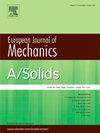微结构缺陷取向相场模型
IF 4.4
2区 工程技术
Q1 MECHANICS
引用次数: 0
摘要
微裂纹、微空洞和其他此类缺陷通常会凝聚形成宏观裂纹,可通过材料点(即微区域)的不相容局部旋转来表示。具体来说,我们基于微观或 Cosserat 连续体假说(该假说要求将导演附加到材料点上),在准脆性损伤过程中跟踪不断变化的框架旋转,进而跟踪微观结构取向。我们引入了包含脆性张量的临界能量释放率,而脆性张量又是微旋转场及其在受损区域内梯度的函数。伪)旋转场作为描述框架场的附加自由度出现,其演变在通过脆性断裂相场公式得到的不断演变的损伤扩散区域内尤为重要。我们强调,在我们的方法中,脆性张量只出现在断裂能量中,而不像微极性连续体那样对弹性能量有贡献。因此,在没有损坏的情况下,固体符合经典连续体。通过对弹性能量中的项进行适当修改并应用虚功原理,我们得出了控制偏微分方程(PDEs)。为了评估所提出的框架,我们选择了一种特定形式的能量密度,并通过数值示例演示了新引入参数的效果。通过关闭微旋转,经典相场模型很容易恢复。此外,我们还探讨了该模型在表示和传播初始缺陷方面的潜在应用。本文章由计算机程序翻译,如有差异,请以英文原文为准。
A microstructural defect-orientation informed phase field model
Micro-cracks, micro-voids and other such defects, which typically coalesce to form macroscopic cracks, could be represented through incompatible, local rotations of material points, i.e. micro-regions. Specifically, based on a micropolar or Cosserat continuum-like hypothesis that requires attaching directors to material points, we track the evolving frame rotation and hence the microstructural orientation during quasi-brittle damage. We introduce a critical energy release rate incorporating the wryness tensor, which in turn is a function of the micro-rotation field and its gradient within the damaged region. The (pseudo) rotation field appears as additional degrees of freedom to describe a frame field, whose evolution is particularly significant within a diffused region of evolving damage as obtained through a phase-field formulation of brittle fracture. We emphasize that, unlike micropolar continua where it contributes to elastic energy, the wryness tensor appears only in the fracture energy in our approach. Thus, without damage, the solid conforms to the classical continuum. By making suitable modifications to the terms within the elastic energy and applying the principle of virtual work, we arrive at the governing partial differential equations (PDEs). For assessing the proposed framework, we choose a specific form of energy density and demonstrate, through numerical examples, the effect of the newly introduced parameters. The classical phase-field model is readily recovered by switching off the micro-rotation. Additionally, we explore a potential application of this model in representing and propagating initial defects.
求助全文
通过发布文献求助,成功后即可免费获取论文全文。
去求助
来源期刊
CiteScore
7.00
自引率
7.30%
发文量
275
审稿时长
48 days
期刊介绍:
The European Journal of Mechanics endash; A/Solids continues to publish articles in English in all areas of Solid Mechanics from the physical and mathematical basis to materials engineering, technological applications and methods of modern computational mechanics, both pure and applied research.

 求助内容:
求助内容: 应助结果提醒方式:
应助结果提醒方式:


